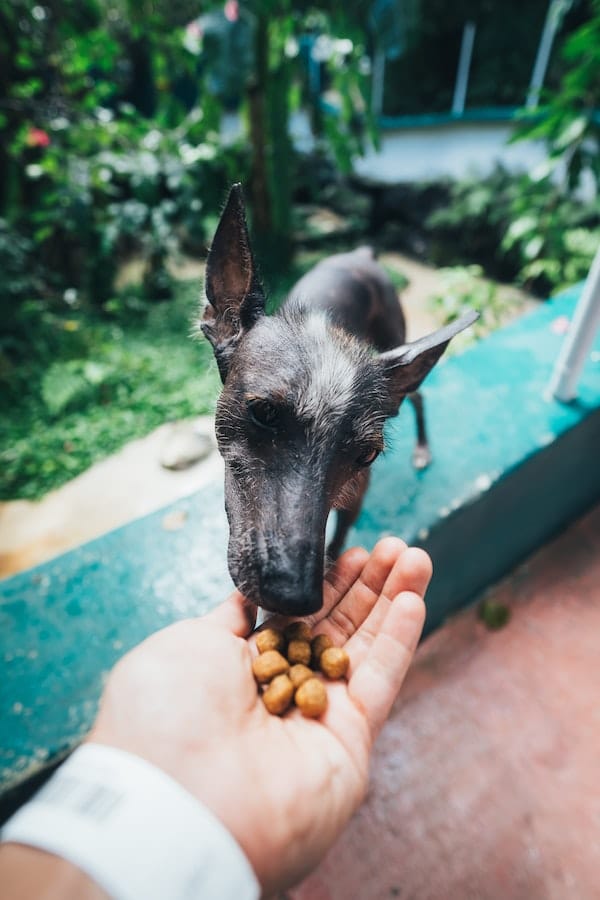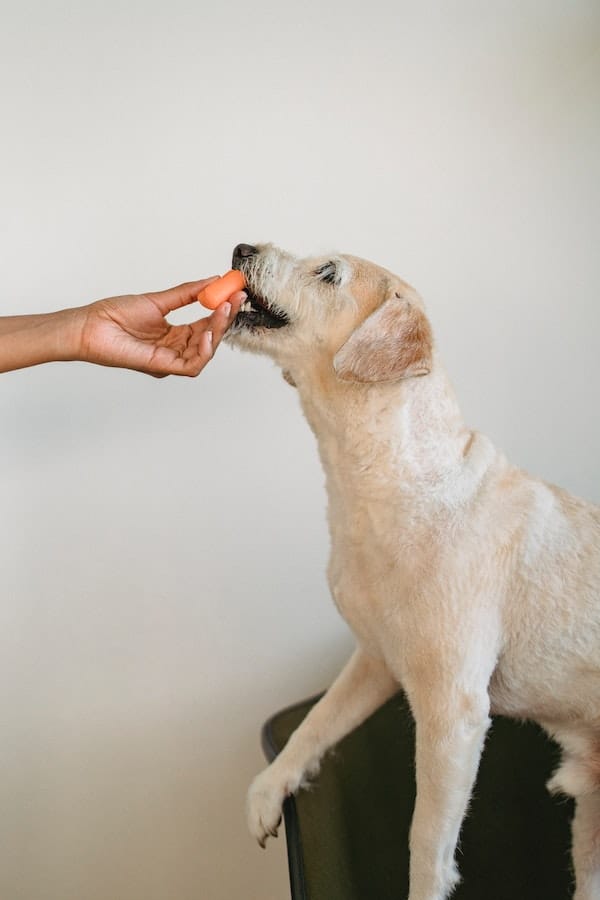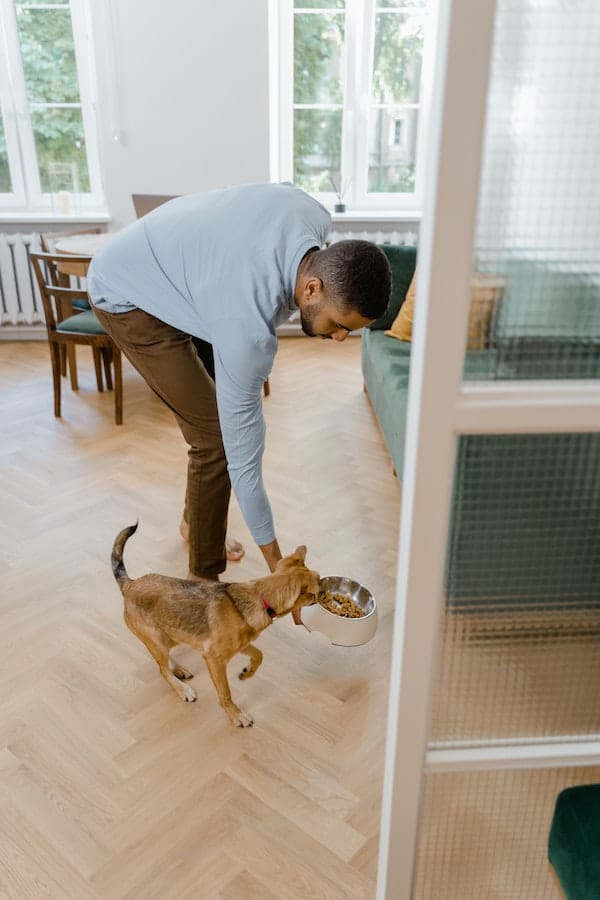
Welcome to our comprehensive guide on addressing dog food aggression, a prevalent behavioral concern among our canine companions.
This issue can raise worries for both pet owners and their four-legged friends.
In this article, we’ll delve into the common indicators and behaviors linked to food aggression, delve into the root causes, and offer practical advice on prevention and management.
Our goal is to ensure a secure and peaceful mealtime experience for your cherished furry companion.
Common Signs and Behaviors Associated with Food Aggression
Dogs can display various behaviors related to food that may raise concerns for their owners. Let’s delve into these food-related behaviors in greater detail:
Growling and snapping
One common food-related behavior is growling, snapping, or showing teeth when someone approaches while the dog is eating.
This behavior is often rooted in the dog’s instinct to protect their meal.
It can be alarming but serves as a clear warning that the dog feels threatened or possessive of their food.
Guarding food
Dogs may exhibit food-guarding behaviors by hovering over their food bowl, becoming tense, or even growling when someone approaches.
This is a defensive reaction, and Bulldogs may engage in food guarding as a way to ensure they have uninterrupted access to their meal.
Stiff body language
Food-aggressive dogs may display stiff body language when guarding their food.
Raised hackles, a rigid posture, and a fixed gaze are common indicators of tension and discomfort associated with food protection.
Resource guarding
Food aggression can extend beyond meals and involves guarding other valuable possessions, such as toys, treats, or even a favorite spot.
Resource guarding is a broader behavioral issue that may require specific training and management.
Gulping food
Some dogs may eat their food rapidly, almost as if they fear it will be taken away.
This behavior, known as food gulping, can lead to digestive issues and may be indicative of anxiety or a previous experience of food scarcity.

Causes of Dog Food Aggression
Understanding the root causes of food aggression in dogs unveils a complex interplay of factors that can influence their behavior. These include:
Survival instinct
Food aggression in dogs can often be traced back to their primal survival instinct.
In the wild, where resources are limited, dogs instinctively guard their food to ensure they have enough sustenance to survive.
This deeply ingrained behavior can persist in domesticated dogs, leading to food-related aggression.
Lack of socialization
Inadequate socialization during a dog’s crucial puppyhood phase can contribute to food aggression.
Dogs that haven’t been properly exposed to various people, pets, and environments may exhibit fear or anxiety when faced with these stimuli during mealtime, triggering aggressive responses.
Prior negative experiences
Negative past experiences, such as food scarcity or having their food forcibly taken away, can leave lasting imprints on a dog’s behavior.
These traumatic encounters can foster a sense of insecurity and possessiveness over their meals, leading to food aggression.
Territorial behavior
Some dogs perceive their feeding area as their territory.
They may view approaching individuals, including other pets or humans, as intruders threatening their domain.
This territorial instinct can manifest as aggression during mealtime.
Genetics
Certain breeds of dogs are more predisposed to food aggression than others due to their genetic heritage.
Breeds that were historically bred for guarding or protecting resources may exhibit heightened food-related aggression tendencies.
Competition for resources
Dogs living in multi-dog households or sharing their living spaces with children may face increased competition for food resources.
This heightened competition can trigger food aggression as dogs strive to assert their access to nourishment.

Tips to Prevent Food Aggression in Dogs
Addressing food aggression in dogs requires a multi-faceted approach that prioritizes safety, trust-building, and effective training techniques.
Here are some comprehensive strategies for managing and mitigating food aggression in your furry companion:
Start early
Teach puppies from a young age that human hands near their food are a positive thing by adding treats while they eat.
Do not punish your dog
Punishment can exacerbate food aggression problems by increasing anxiety and fear. Instead of punishing your dog, focus on positive reinforcement and behavior modification techniques.
Hand-feeding
Hand-feeding can foster trust and reduce the likelihood of food aggression. Feeding your dog from your hand helps them see you as a source of nourishment and builds a positive bond.
Obedience training
Basic obedience commands such as “leave it” and “drop it” are invaluable tools for managing food aggression.
These commands enable you to redirect your dog’s focus and control their behavior during mealtime.
Respect their space
Allow your dog to eat in peace without disturbance. Create a designated feeding area where your dog feels safe and secure.
Manage the situation
Depending on the severity of your dog’s food aggression, consider practical measures such as feeding your dog in a separate room from other people and pets or using a raised platform to elevate its food bowl.
Desensitize your dog
Gradually desensitize your dog to your presence while they eat.
Start by standing at a distance where your dog is not aggressive and, over time, gradually move closer.
This gradual approach helps your dog become more comfortable with your presence during mealtime.
Counter-condition
Counter-conditioning involves pairing food with positive experiences, such as petting or praise.
By associating your presence with positive outcomes, your dog can learn to feel more relaxed during mealtime.

Consult a professional
If food aggression persists or is severe, it’s advisable to seek guidance from a professional dog trainer or behaviorist.
They can provide specialized training techniques and tailored solutions to address your dog’s specific needs.
Conclusion
Food aggression is a prevalent concern among dog owners, but with the right approach, it can be effectively handled.
The key lies in keenly observing your dog’s behavior, comprehending the underlying reasons, and taking proactive measures to ensure mealtime remains a calm and pleasant experience for both you and your furry friend.
FAQs
Food aggression can occur in any breed, but some individual dogs may be more prone to it than others. It’s essential to be aware of the signs and address the issue promptly.
While it may not always be completely eliminated, food aggression can be effectively managed through training and consistent positive reinforcement techniques.
Punishment can exacerbate food aggression. It’s better to use positive reinforcement, training, and professional guidance to address the issue safely and effectively.
Dogs with food aggression can still make wonderful pets with the right training and management. However, it’s essential to be prepared to address and work on this behavior if you choose to adopt such a dog.
- Essential Oils Safe for Cats: What Every Pet Owner Needs to Know - May 23, 2025
- Herbal Supplements for Cats: A Natural Approach to Cat Wellness - May 21, 2025
- Signs of a Healthy Cat Coat: What Every Cat Owner Should Know - May 19, 2025


GIPHY App Key not set. Please check settings